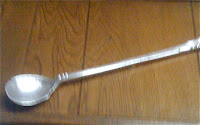Nevertheless, Cellini Craft aluminum pieces hold a cherished place in the collections of many collectors.
The small candleholder shown left is definitely a favorite among the small holders in my collection.This holder was featured on a page mentioned in last week's article and described as the Argental line with an oval rimmed bobeche atop two flower-shaped bases with four small ball feet on the bottom." The Argental mark is also shown there
I have a weakness for candleholders, although years ago I sold several larger ones because of limited display space. Now, I wished I had simply packed them away!
 |
| Deep Avon bowl |
 |
| Cellini shallow bowl |
The delicate wire decoration between the wide scalloped edge makes this shallow bowl by Cellini, a special piece to use for a stack of fruit or for a generous serving of cookies.
 |
| Covered serving bowl by Cellini |

All three of the small Cellini trays above have a style reminiscent of that of silver pieces. Apparently the company did not venture far astray from their past when they switched to a cheaper metal.
 |
| Covered Cellini server |
As far back as 1914, Ernest Gerlach opened a shop in Evanston Ill. He choose the name Chellini Shop after Benvenuta Cellini, a renowned Renaissance goldsmith (whose life story makes interesting reading). He hired several silversmith, including the talented Hans Gregg and William Conrad both from Germany. The company produced countless numbers of silver items, most of which are in great demand today. Depression days affected their business, as it did all businesses across the nation and in 1934 aluminum wares were added to their line of products.
It was called Argental, meaning silver-like. As with many other companies, the logos or marks were changed numerous times, and the letters M and W were added at one time. These were the initials of Max Willie, an East Coast distributer who also handled the wares of Shup Laird.
A search for Cellini indicates that the company still operates but details or not available.In fact, a Google search is cluttered with the name with shops featuring shoes, leather jackets, dinner wares and silver adopt the name. However, its history shows that in 1957 it was sold to the Randahl Company, whose main purpose was to acquire its metalsmiths. Argental items continued to be made until 1965, when these dies and designs were purchased by Reed an Barton. Rdandahl eventually purchased what was left of Cellini in 1969, and ended the creation of custom metalwork.
There are several other companies that produced items similar to those of Cellini, the most prolific being Moderne who also used simple styling and a series of cunning tile scenes that make their wares desirable.
As always, your comments and questions are looked forward to, and I hope you'll be responding soon.
Dannie











